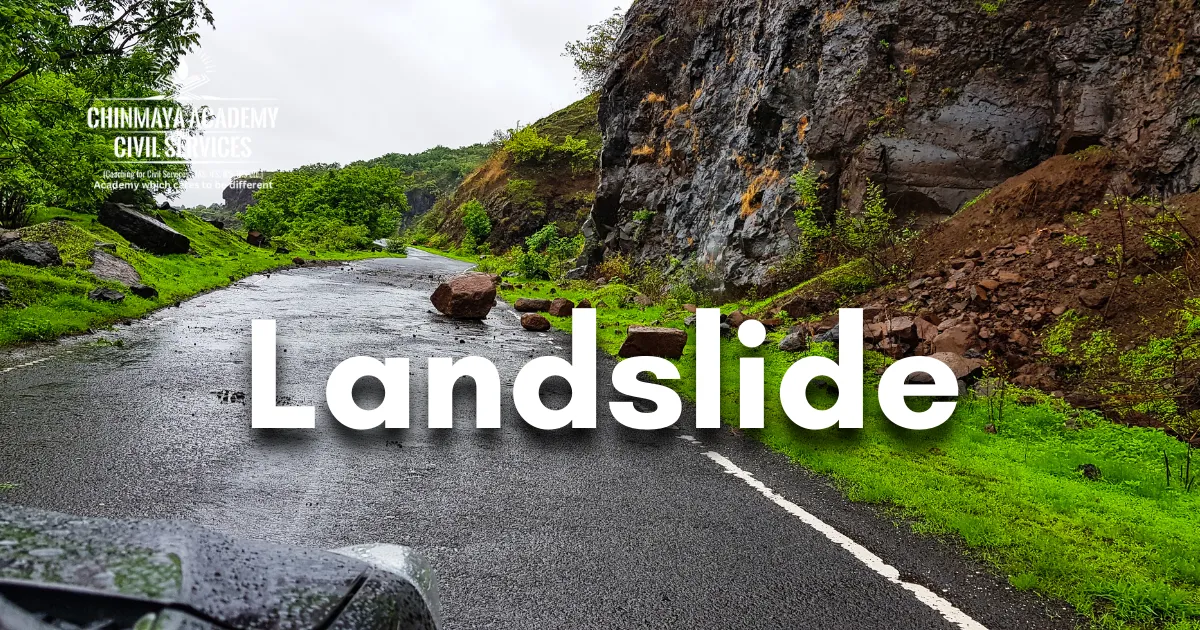
A landslide, also known as a landslip, is a rapid downward movement of a mass of rock, earth, or debris on a slope. It’s a type of mass wasting, which refers to any downslope movement of soil and rock under the influence of gravity.
Why in NEWS:
An IIT-Delhi team creates India’s first high-resolution landslip risk map.
- Due to its nationwide scope and inclusion of all regions of the nation, the “Indian Landslip Susceptibility Map” is the first of its kind.
- The map and the researchers’ analysis will be published in the February 2024 issue of the journal Catena.
In India, landslides are a particular and dangerous issue. They are less common and more difficult to track and analyse with satellites than floods. Landslides only affect 1% to 2% of the nation and occur in extremely localised areas. Consequently, the amount of high-quality data available for use with standard machine-learning models is significantly reduced.
About landslides:
Types: Landslides come in various types, categorized by the type of material moving and the movement’s speed and nature. Some common types include
- Rockfalls
- Mudflows
- debris flows.
Causes: Multiple factors can trigger a landslide, including:
- Increased water content: Heavy rainfall, snowmelt, or rising water levels can add weight and reduce the stability of the slope.
- Erosion: Over time, erosion can weaken the slope and make it more susceptible to movement.
- Earthquakes: Seismic activity can shake the ground and destabilize slopes.
- Human activities: Activities like construction, mining and deforestation can alter the slope’s stability and increase the risk of landslides.
Consequences: Landslides can be devastating, causing damage to infrastructure, disruption of transportation networks, and loss of life. They can also have long-term effects on the environment.
Landslide-Prone Areas in India:
India is unfortunately quite prone to landslides, with various regions facing different levels of risk.
High Vulnerability:
Himalayan Region: These regions experience frequent landslides due to steep slopes, heavy rainfall, and seismic activity. This includes states like
- Uttarakhand
- Himachal Pradesh
- Jammu and Kashmir
- Sikkim
- Arunachal Pradesh.
Northeastern Region: These regions are susceptible due to similar factors as the Himalayas, along with weaker soil structures and deforestation.
- Assam
- Nagaland
- Mizoram
- Manipur
- Tripura
- Meghalaya
Moderate Vulnerability:
Western Ghats: These regions face landslides, particularly during the monsoon season, due to steep slopes and intense rainfall. States like
- Kerala
- Maharashtra
- Karnataka
- Tamil Nadu
Eastern Ghats:
- The Araku Valley in Andhra Pradesh and parts of Odisha are at risk due to steep slopes and soil erosion.
Vindhyan Hills:
- Parts of Madhya Pradesh and Uttar Pradesh experience occasional landslides, especially during heavy rainfall.
 Chinmaya IAS Academy – Current Affairs Chinmaya IAS Academy – Current Affairs
Chinmaya IAS Academy – Current Affairs Chinmaya IAS Academy – Current Affairs